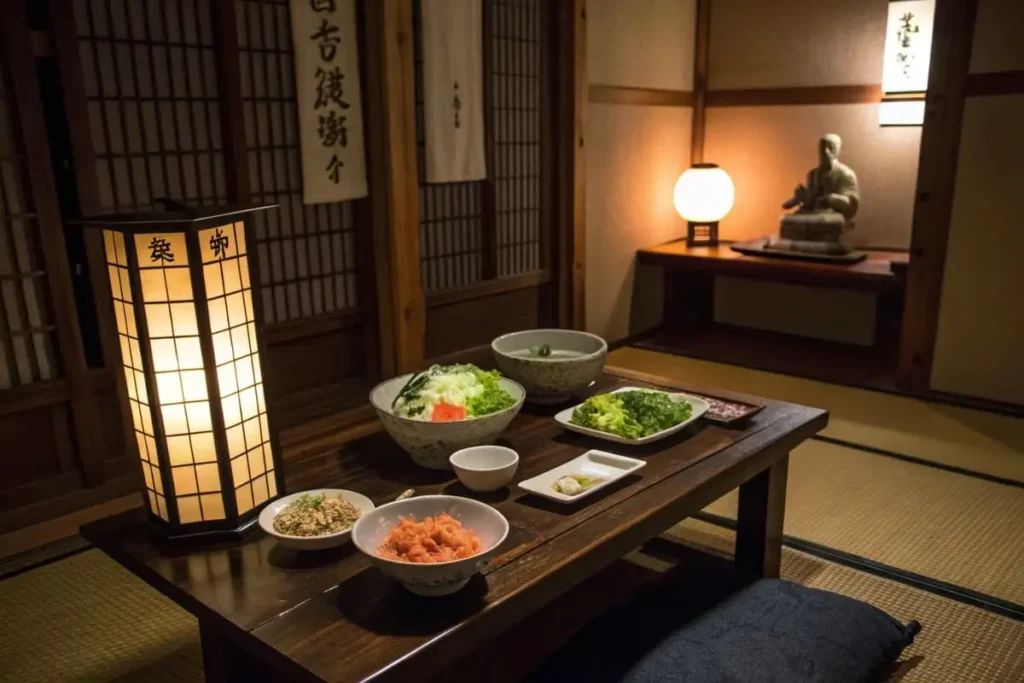Shinto—often referred to as the “Way of the Gods”—is a centuries-old tradition permeating much of Japan’s cultural, social, and spiritual life. With its focus on kami (divine spirits) believed to inhabit elements of nature, Shinto fosters a profound respect for the environment. Does shinto affect japanese food? Absolutely, albeit in an indirect, nuanced manner. Rather than imposing strict dietary rules or forbidding certain meats, Shinto influences are reflected in the emphasis on seasonal produce, the tradition of minimal waste, and the deep sense of gratitude Japanese people often express for the ingredients they consume.
Imagine a meal at a traditional Japanese household: the rice is carefully rinsed until water runs clear, fish is chosen for optimal freshness, and the meal layout is balanced to showcase nature’s colors. These choices mirror Shinto’s reverence for purity and harmony. In daily life, Japanese people might not explicitly say they’re following Shinto rules while cooking, but the religion’s underlying values echo throughout their gastronomic habits.
If you want a taste of how these spiritual underpinnings integrate into real recipes, check out our Traditional Japanese Desserts Recipe. Even in sweets, you’ll observe an intrinsic balance—small, seasonal servings that highlight natural flavors—reflective of Shinto’s subtle yet enduring impact. Let’s delve deeper into these spiritual-laced culinary customs, from historical contexts to everyday mealtime.
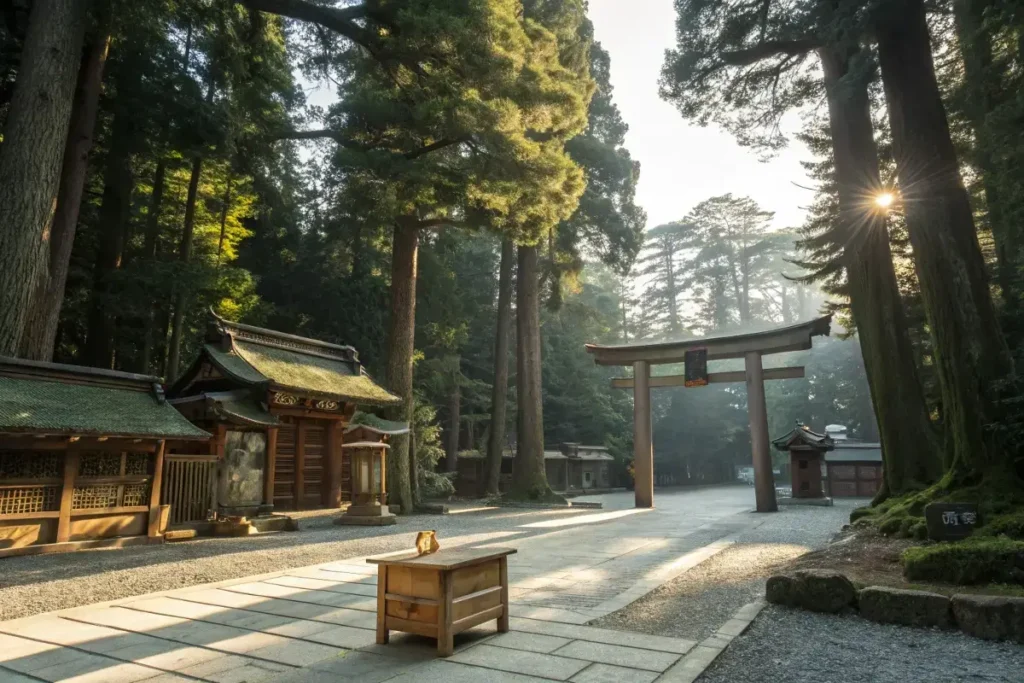
Understanding Shinto’s Core Beliefs and Food Customs
1. The Essence of Shinto
Shinto revolves around a reverence for kami—spirits residing in natural elements like rivers, mountains, trees, and ancestral entities. These kami are not distant gods but intimately connected to daily life. The concept extends to how Japanese perceive resources: each grain of rice or fish from the sea is a gift from nature, deserving of respect. This ethos gently shapes how does shinto affect japanese food, pushing for minimal waste and careful ingredient use, rather than strict thou-shall-not dietary codes.
2. Purity and Cleanliness
A fundamental Shinto theme is kegare (impurity) versus kiyome (purity). Ritual purification is visible in shrines, where visitors rinse hands and mouth before entering. Translating this to food, we see:
- Meticulous Washing: From thoroughly washing produce to removing fish blood or offal, the goal is to remove anything deemed impure.
- Simple Seasonings: Japan’s basic staples—soy sauce, miso, dashi—enhance natural flavors instead of burying them, reflecting purity in taste.
3. Seasonal Reverence
Shinto-based festivals have long celebrated harvests, encouraging people to consume produce at its peak. This seasonal approach, now integral to Japanese culinary identity, stems from thanking the kami for timely abundance. Whether it’s takenoko (bamboo shoots) in spring or kabocha (pumpkin) in autumn, Shinto’s awareness of nature’s cycles is deeply woven into meal planning.
4. Gratitude in Everyday Dining
While Japan is diverse in beliefs—mixing Buddhism, secular habits, and modern lifestyles—trace elements of Shinto gratitude remain:
- Saying “Itadakimasu”: This phrase means “I humbly receive,” reflecting an awareness that life—be it plant or animal—was taken to provide nourishment.
- Waste Minimization: People value using every edible part to honor the resource. This stands in line with Shinto’s concept of respecting living organisms.
5. Unwritten Norms Instead of Bans
What can’t shintos eat? Shinto is more about harnessing nature’s gifts responsibly than forbidding certain foods. Historically, meat consumption was low due to Buddhist influences, not Shinto law. Modern Japanese diets include fish, seafood, poultry, and pork without viewing them as spiritually “impure.” However, the manner of procurement—like sustainable fishing or humane butchery—can echo Shinto’s respect for life.
For a flavor of minimalist but profound cooking, see our Japanese Vegan Recipes. Though not strictly mandated by Shinto, a plant-based approach can align with the religion’s gentle stewardship of nature. The ethos here is about forging harmony—between the eater, the environment, and the spirit.
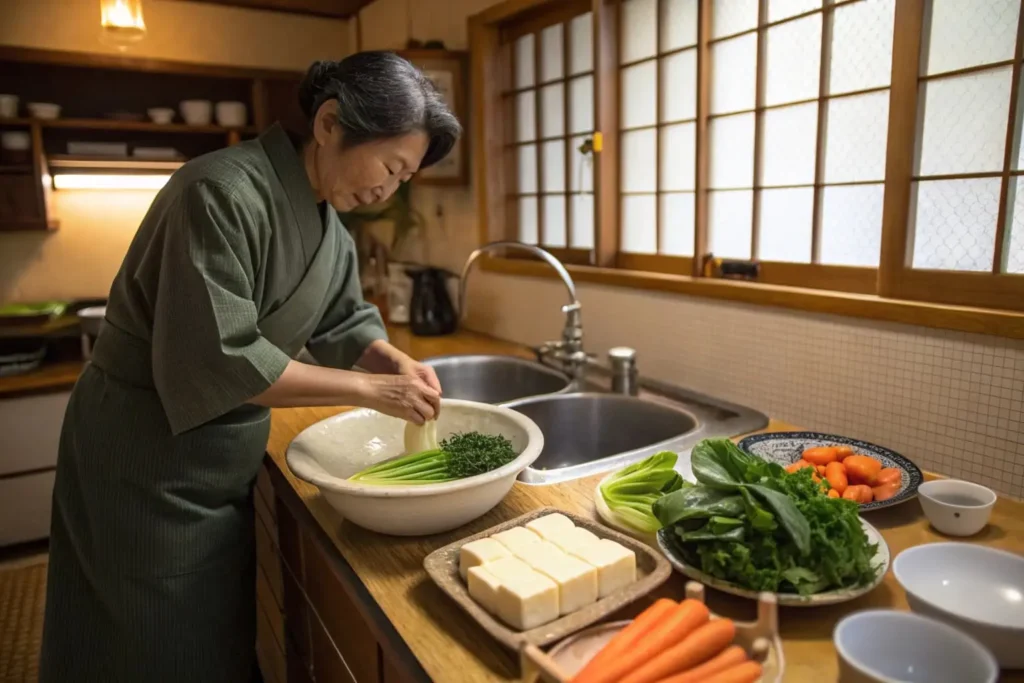
Historical Evolution – Shinto’s Role in Shaping Japanese Cuisine
Ancient Harvest Rituals and Offerings
Long before formal religions arrived, Japanese agrarian societies revered nature’s bounty through Shinto-like practices. Ceremonies like Niiname-sai featured the Emperor offering first-harvest rice to the gods, reinforcing the synergy between farmland, kami, and communities. Over centuries, these traditions stabilized, forging a communal sense of gratitude that spread through local cuisines.
Influence of Buddhism and Cultural Melding
When Buddhism entered Japan around the 6th century, it brought ideas like abstaining from taking life. Though not an outright Shinto principle, it blended with Shinto’s respect for living beings. The result? A cultural preference for fish over red meat for centuries. Some might attribute this partially to Shinto, but it’s more a Buddhist synergy. Still, the shared outcome—moderation in meat consumption—aligned with Shinto’s non-exploitative stance on resources.
Edo Period: Culinary Flourishing
During the Edo period (1603–1868), Japan’s isolation policy ironically allowed domestic food culture to flourish. Freed from large-scale external influences, local markets refined fish-handling, vegetable cultivation, and artisanal condiments. Shinto shrines also hosted harvest festivals, offering prepared dishes to kami, thereby reinforcing a loop: from produce gleaned from land or sea to communal and sacred consumption.
- Local Specialties and Regional Identity:
Different regions specialized in certain crops or fish, tying local shrine events to those ingredients. Visitors often associated the local kami’s blessings with that region’s unique produce. - Temple and Shrine Influence:
While Shinto shrines weren’t as prescriptive about diet as Buddhist temples, occasional rituals involving special sake or rice-based offerings maintained that sense of the divine in everyday nourishment.
Modern Shifts and Globalization
After Japan opened to the West in the late 19th century, new foods like beef, bread, and dairy surged in popularity. Shinto’s overarching respect for nature didn’t vanish but found new contexts:
- Western Restaurants in Japan: Even steak or hamburgers were prepared with care for presentation, possibly reflecting Shinto’s aesthetic and mindful approach to food, though many might see it as purely Japanese craftsmanship.
- Environmental Movements: In the 20th century, emerging eco-awareness echoed Shinto’s old principle of living in harmony with the land. Many organic farms or community-supported agriculture groups in Japan feel reminiscent of Shinto ideals, maintaining small-scale, respectful farming.
Festivals and Their Culinary Echoes
Shinto-based festivals—like Gion Matsuri in Kyoto or local rural harvest celebrations—often highlight seasonal dishes. Stalls might sell yakisoba, takoyaki, or grilled fish in a vibrant atmosphere. Although these foods have no explicit spiritual ban or requirement, the act of communal feasting under shrine lights captures the spirit of gratitude and joy that Shinto fosters.
If you’d like to replicate a dish that merges tradition and modern influences, see our Japanese Steak Recipe for an example of how local technique and marinade philosophies can merge with Western cuts of meat—still reflecting the idea of respectful ingredient handling. Each new era in Japan’s history layers upon the last, but Shinto’s bedrock principles remain: reverence, simplicity, and co-existence with the natural world.
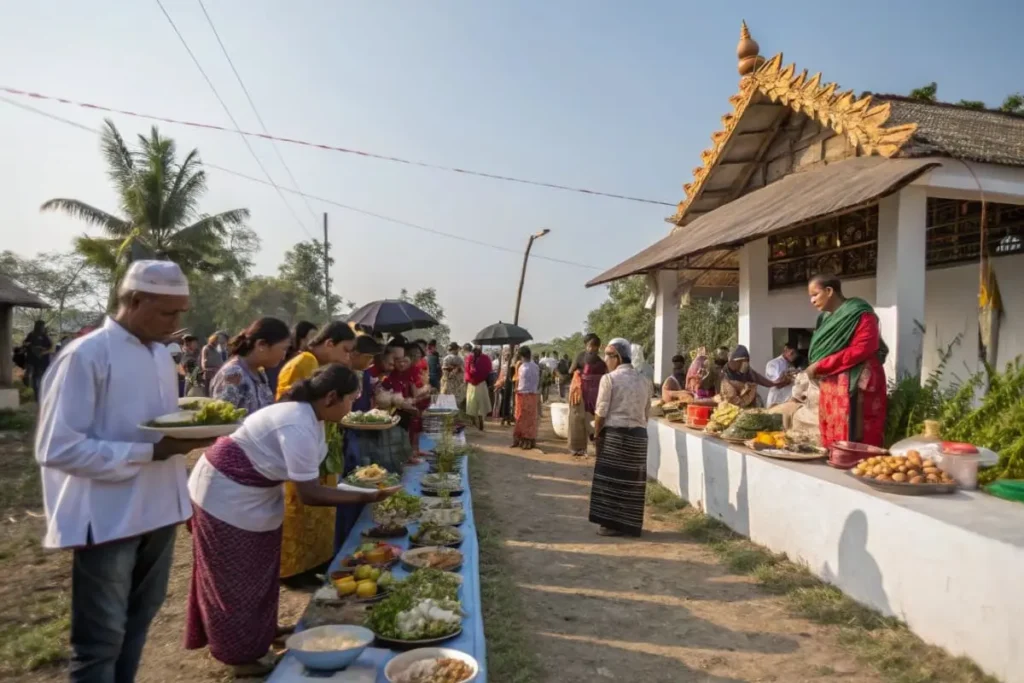
Practical Manifestations in Everyday Japanese Food Culture
Seasonal Menus and Ingredient Respect
Japan’s obsession with shun (seasonality) stems from Shinto’s reverence for nature’s timing. Many restaurants rotate menus monthly or quarterly, highlighting:
- Sakura Delights in Spring: From sakura mochi to pink-themed pastries.
- Fresh Bamboo Shoots: Celebrated in April/May, lightly boiled or simmered to accentuate their natural sweetness.
- Autumn Koyo Cuisine: Mushrooms, persimmons, and chestnuts, revered for symbolizing harvest abundance.
This cyclical approach ensures minimal environmental strain, as chefs use what nature provides at its prime. It fosters a sense of gratitude—akin to Shinto’s principle that each harvest season is a gift from kami.
Dining Etiquette Reflecting Spiritual Influences
- Thanking the Ingredients:
Common phrases like itadakimasu (“I humbly receive”) before a meal and gochisousama deshita (“thank you for the feast”) afterward encapsulate gratitude to the cook, the farmer, and nature itself. - Shared Plate Mindset:
In many Japanese dinners, side dishes are communal, echoing a sense of harmony. This communal aspect fosters less waste and more appreciation for each dish.
Shinto Concepts in Cooking Techniques
- Minimal Processing: Japanese dishes often revolve around raw or lightly cooked items, from sushi to tempura. The integrity of the original flavor remains, reflecting the Shinto idea that nature’s kami is already perfect.
- Clean, Uncluttered Presentations: Plating is often symmetrical or visually balanced, symbolizing harmony and clarity—spiritual aesthetics beyond mere style.
Examples of Shinto’s Subtle Impact
- A Family Gathering:
A mother includes a seasonal fish in the meal, ensures leftover fish bones are used for stock, and recycles vegetable scraps into compost. She’s not “following Shinto rules” officially, but her approach resonates with Shinto’s respect for resources. - Restaurant Interiors with Mini Shrines:
Occasionally, you’ll spot small kamidana (Shinto altar) or talismans in a restaurant’s back corner. The owner might offer silent prayers for prosperity and the health of customers, bridging daily commerce with spiritual acknowledgement.
Overlaps with Other Cultural Factors
While does shinto affect japanese food stands true, it’s important to note it’s not the only factor. Buddhist influences, secular preferences, and the general Japanese aesthetic sense (wabi-sabi, minimalism, etc.) all intersect. Nonetheless, Shinto’s “nature is divine” principle underpins them all. For instance, if you’re exploring how Japanese people integrate produce-based cooking in a mindful manner, peruse our Vegetables Japanese Recipe. Such dishes highlight the earthy purity central to Shinto’s perspective.
Ultimately, every time a cook selects ingredients at their peak, washes them meticulously, or arranges them with quiet artistry, they echo centuries of Shinto-minded respect. This intangible synergy between faith and fare fosters the refined simplicity that captivates global audiences in Japanese cuisine.
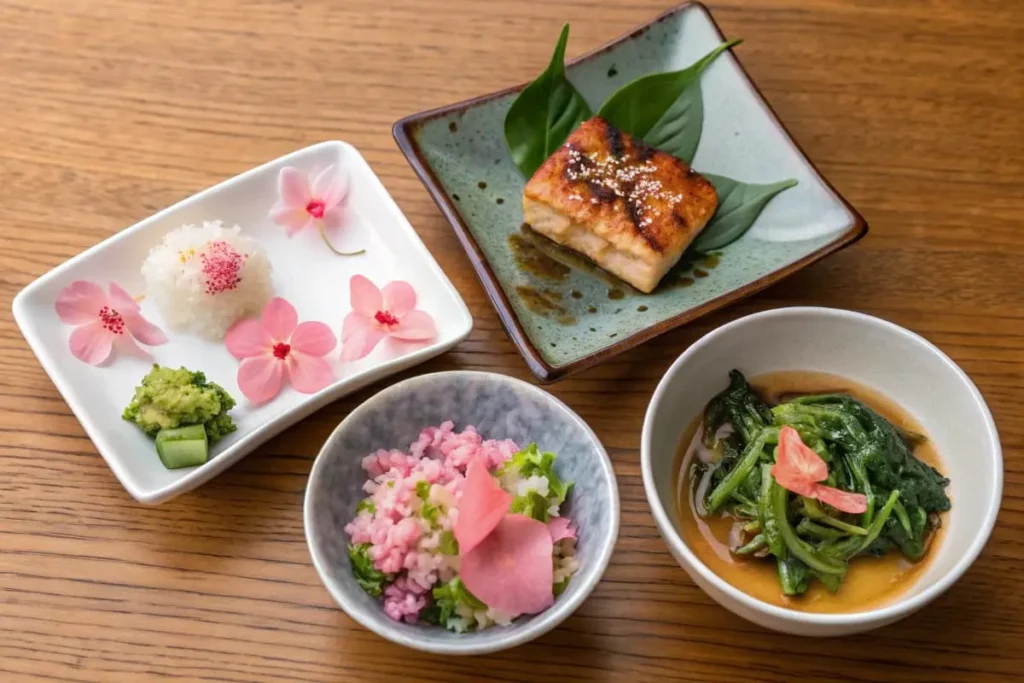
History and Examples
Notable Historic Cases
- Imperial Court Banquets:
During the Heian period, palace meals featured refined dishes using local fish and produce. Though these banquets had a Confucian and aristocratic flair, Shinto’s presence lingered in harvest offerings and the Emperor’s role as a spiritual intermediary. - Village Festivals:
In rural Shinto shrines, harvest festivals often included prepared foods shared among villagers, symbolizing the blessings from the local kami. The notion that communal feasting fosters unity resonates to this day.
Real-World Anecdotes
- Bean Throwing in Spring: Although Setsubun is more a Buddhist/Taoist hybrid, the practice of scattering roasted soybeans to ward off evil touches on Shinto-Buddhist syncretism. Food becomes both a spiritual tool and a playful tradition.
- Weddings and Ceremonial Sake: Shinto wedding rites see the couple exchanging san-san-kudo sips of sake, unifying families under the presence of kami. While not “food,” it exemplifies how ingestible items (sake, in this case) serve spiritual and symbolic roles.
Contemporary Observances
Today, many shrines occasionally host events demonstrating how local farmers or fishers bring their produce to be blessed. The priests conduct a brief ceremony, ensuring safe harvest and productivity. While such gatherings might not always be open to the public, they highlight a living tradition that ties Shinto’s spiritual outlook to gastronomic appreciation.
- Community Rice Planting:
Some regions invite visitors or city dwellers to join in rice planting or harvesting under shrine supervision. The event may end with an outdoor meal featuring fresh local products, linking spirituality, labor, and dining into a single communal act. - Temple Food Stalls:
Large festivals like Kyoto’s Gion Matsuri, albeit not purely Shinto, still revolve around a major Shinto shrine (Yasaka Shrine). Food stalls selling yakitori, takoyaki, or shaved ice fill the streets, merging commercial festivity with spiritual ambience. The atmosphere resonates with Shinto’s acceptance of communal joys around nourishment.
Global Echoes
Japanese restaurants overseas occasionally replicate these ceremonial or harvest notions—like celebrating a “Sakura festival” menu or launching an “autumn special” featuring mushrooms. Customers may only see it as “seasonal flair,” but it underscores how does shinto affect japanese food extends globally, inspiring chefs worldwide to adopt a seasonal, respectful stance.
If you’d enjoy a fusion of old and new in your next meal, consider our Japanese Chicken Fried Rice Recipe—a dish that, while modern, still upholds the idea of carefully handled ingredients, minimal waste, and a sense of gratitude. Bridging the past and present is precisely how Shinto’s enduring spirit thrives in Japanese food culture.
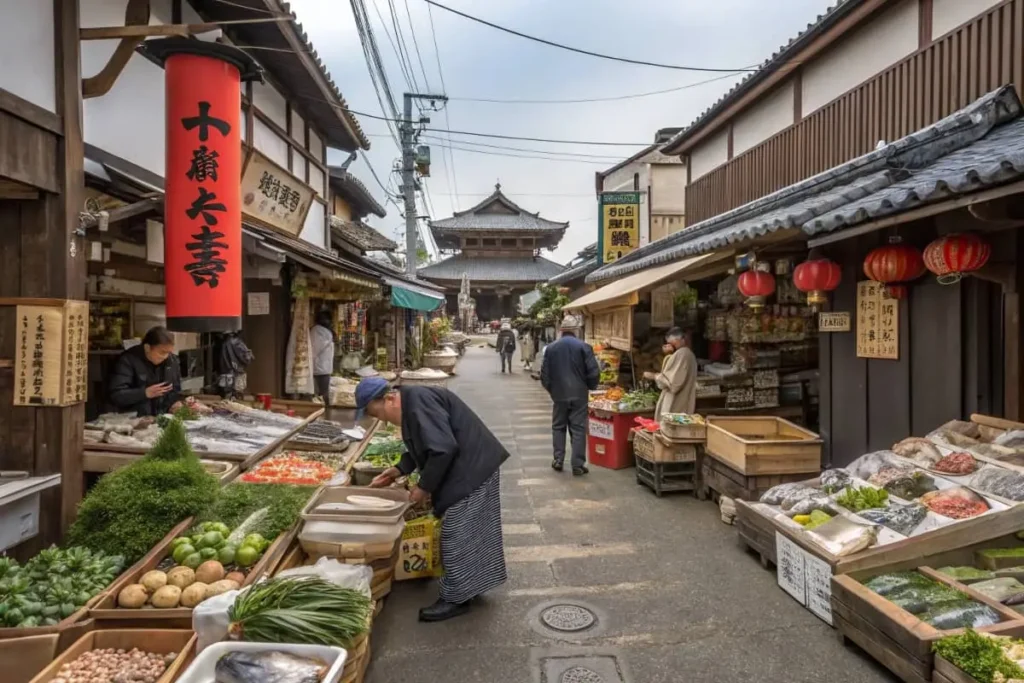
Practical Examples/Use Cases
Does shinto affect japanese food? Yes, and these real-life instances show how:
1. Home Cook Embracing Seasonal Veggies
Scenario: A Tokyo homemaker aims for a meal highlighting early summer produce.
- Implementation: She shops at a local farmers’ market, picking fresh peas, young carrots, and a small fish catch of the day. Sautéed lightly with miso or soy sauce, the meal emphasizes each item’s essence.
- Shinto Link: The focus on shun (peak-season foods) honors nature’s cyclical generosity, a subtle echo of Shinto.
2. Chefs’ Zero-Waste Philosophy
Scenario: A Michelin-starred restaurant in Kyoto fosters a “no waste” policy.
- Implementation: Vegetable trimmings go into stocks, fish bones are used in dashi, and leftover scraps become compost.
- Shinto Link: Shows reverence for each ingredient, refusing to discard potential nourishment. This ethos parallels Shinto’s respect for life.
3. Festive Community Meal
Scenario: A local shrine organizes a summer festival, providing free yakisoba or rice porridge to attendees.
- Implementation: Volunteers cook large batches. After a brief blessing ceremony, everyone feasts in a lively atmosphere of gratitude.
- Shinto Link: Food distribution fosters communal unity, acknowledging kami blessings and strengthening social bonds.
4. Corporate Cultural Workshop
Scenario: An international firm in Japan arranges a team-building exercise learning washoku.
- Implementation: A local teacher demonstrates minimal seasoning, emphasizing each ingredient’s natural aroma. Participants practice mindful cooking, concluding with a shared meal.
- Shinto Link: Encourages a reflective approach to cooking, reminiscent of Shinto’s principle that we are caretakers, not dominators, of resources.
For an accessible place to start exploring these values at home, try our Mashed Japanese Sweet Potato Recipe. By focusing on the sweet potato’s inherent flavor, we capture that sense of simplicity and respect for produce central to Shinto’s unspoken guidelines. Each spoonful becomes a subtle homage to nature’s generosity, bridging tradition and everyday convenience.
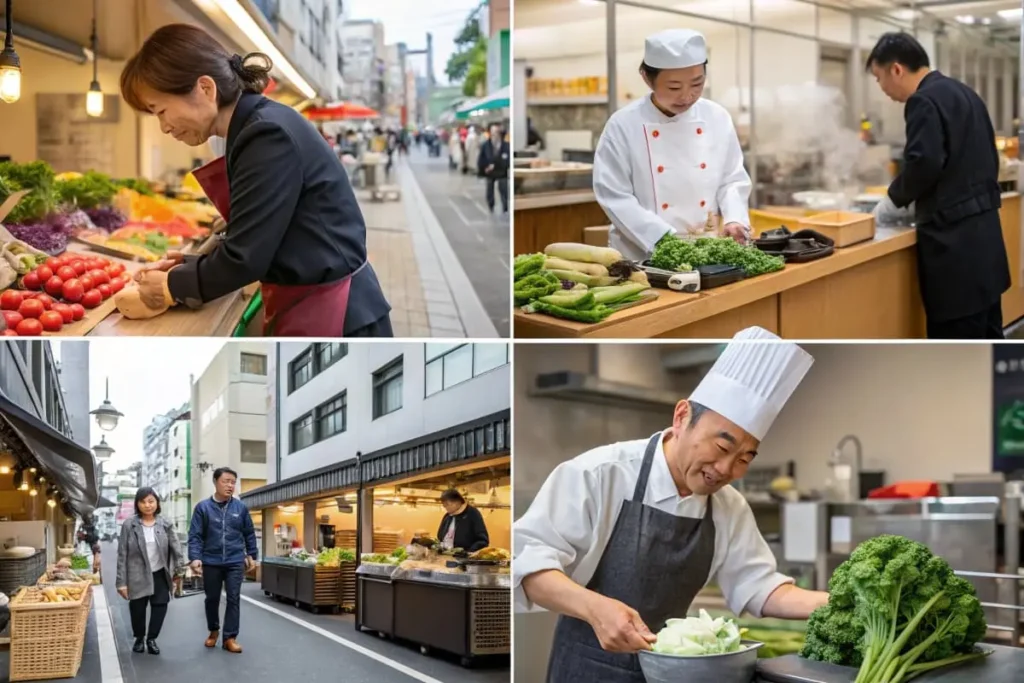
FAQs
1. How does Shinto affect Japanese food?
Shinto’s emphasis on nature’s sacredness manifests as respect for fresh, seasonal ingredients and careful, minimal-waste preparation. There’s no official list of forbidden foods—rather, chefs and home cooks adhere to a principle of gratitude, purity, and balance, letting each dish shine with minimal interference.
2. How does Shintoism affect Japanese culture overall?
Beyond cuisine, Shinto shapes festivals, community gatherings, and the national ethos of living in harmony with one’s environment. Ritual cleanliness, polite manners, and an appreciation for seasonal change trace back to Shinto’s worldview of kami pervading daily life.
3. Does religion affect food in Japan?
Yes, but in a softer manner than in faiths with strict dietary laws. Japan’s spiritual tapestry mixes Shinto and Buddhism, inspiring mindful resource use, seasonal appreciation, and a tendency to eat fish over red meat (historically). Today, many Japanese eat a diverse range of foods, with the Shinto effect mostly seen in attitudes rather than formal rules.
4. What can’t shintos eat?
There’s no official prohibition. Some families might avoid strong-smelling meats during certain shrine-related events, but it’s more tradition than law. Shinto focuses on purity and gratitude rather than forbidding specific foods.
5. Do Shinto festivals include special dishes?
Certain shrine events distribute mochi, sweet beans, or local produce to highlight a successful harvest. While these offerings remain context-specific, the concept of blessing and unity underscores Shinto’s role. These events illustrate the spiritual dimension of communal feasting rather than a nationwide mandated dish.
6. Is there a “Shinto diet”?
No. Shinto lacks the codified dietary strictures found in some religions. Instead, it upholds nature’s gifts, minimal waste, and a balanced approach to what you eat. Many interpret this as preferring local, fresh, and respectfully sourced ingredients.
7. Do travelers experience Shinto’s influence in Japanese restaurants?
Yes, though it may be subtle. For example, a focus on aesthetic plating, fresh fish, or seasonal specials quietly echoes Shinto’s ideals of purity and nature’s cycles. Some restaurants place small shrines or talismans to invite good fortune and show reverence to the kami.
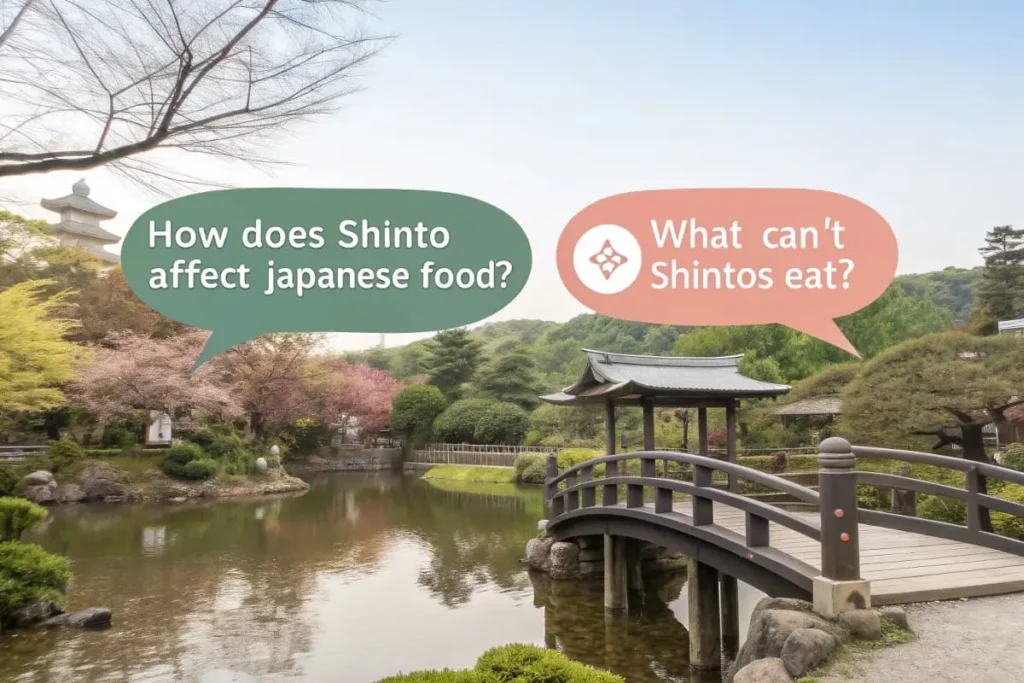
Conclusion
Does shinto affect japanese food? The quick answer is yes, but not through rigid dietary laws. Shinto’s spiritual reverence for nature and focus on purity resonates throughout Japanese cooking and dining customs. Whether it’s carefully washing rice, spotlighting seasonal produce, minimizing waste, or simply whispering a quiet “Itadakimasu” before a meal, the essence of Shinto subtly shapes these everyday routines. Food becomes more than nourishment—it’s an interconnection of environment, community, and the kami believed to exist in all things.
For those seeking to embody these principles, focusing on locally sourced, fresh ingredients and maintaining a mindful approach to cooking can channel that sense of spiritual harmony. If you’re looking for a simple dish to start with, try exploring our Japanese Cucumber Salad Recipe, which exemplifies minimal intervention, letting nature’s flavors shine. Ultimately, this quiet interplay between Shinto ideals and modern Japanese food fosters a culinary style that blends aesthetic elegance with moral subtlety, echoing centuries of deeply rooted beliefs about living respectfully with the world around us.
